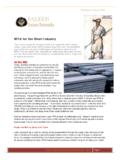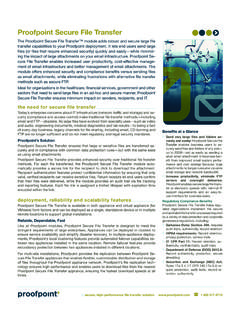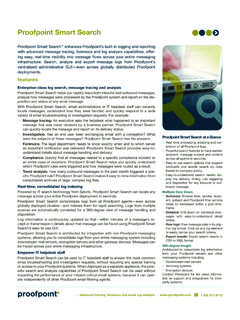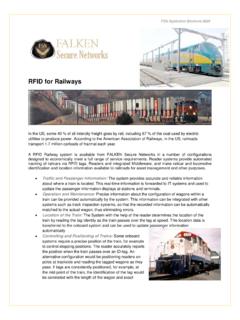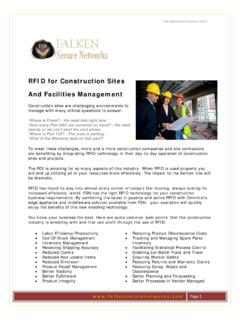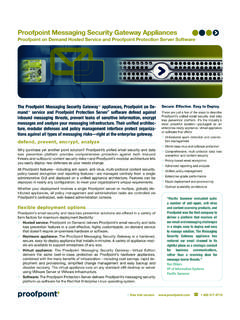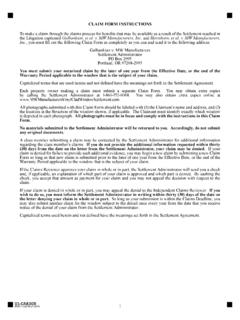Transcription of RFID for Precast Concrete Manufacturers
1 FSN Application Brochure 0829 Page 1 rfid for Precast Concrete Manufacturers Precast Concrete companies are now using passive UHF rfid tags to create an electronic quality-control trail and better manage their inventory. TRACKCON A powerful wireless solution for tracking Concrete structures Know where each item in your inventory is located without spending hours in the yard. Know if an item is ready to ship or waiting for more work before you put it on the truck. Extend this item level tracking out to your customer s job site for superior customer service. Precast Manufacturers make Concrete structures for bridges, roadways, manholes, sewer and water pipes, stairways burial vaults, and various architectural Precast pieces for buildings and parking garage flooring and haul the finished pieces to the construction sites.
2 Quality control is typically accomplished by visually inspecting an item as it is being made. In the USA, if the inspections are recorded, either electronically or on paper, that data record qualifies a company for NPCA certification. The rugged and demanding environment of Concrete precasting means that bar coding identification is not feasible due to the high incidence of tag damage as well as the requirement for line of sight for reading the tag. Increasingly, projects require Precast vendors to have such a certification. Canada has a similar certification program(CPCI) which is designed to be harmonized with the US standards. CPCI Certification has reintroduced common, measurable, nationwide standards for Precast certification with no increased cost to customers. In accordance with the requirements of the National Building Code of Canada, CPCI Certification is aimed to make certification designation a recognized requirement for all project specifications and for all Precast operations.
3 It does have a mandated number of audits annually. Therefore compliance is made much more efficiently by automating some of the data collection and record keeping with rfid technology. Many different pipes are made, different specs and sizes-but can look similar-a potential problem area on a construction site even though a serial number is stamped or painted on the end ring of every pipe. Architectural Precast pieces are typically large but each has its own building mark or position for installation on a building. Hence, each piece is unique. This creates situations where much time can be wasted in searching the large yards, typical of precasters, for the correct piece to ship. FSN Application Brochure 0829 Page 2 These issues create opportunities for rfid to automate the process and create savings in two key areas: Quality Control Yard and Inventory Management QUALITY CONTROL Several US firms are currently using the system to gain National Precast Concrete Association (NPCA) certification allowing it to be a supplier to projects that require such certification from Precast Concrete Manufacturers .
4 Although certification can be accomplished with a pen and paper trail, an electronic system makes record keeping more accurate and easier to manage. The system allows their quality-control officers to read passive UHF rfid tags on the Concrete products as well as on the steel forms in which they are molded, creating an electronic data file that chronicles when the product was made, when it was inspected and by whom. rfid tags are read and corresponding data captured at each definable stage of production. With rfid -enabled employee ID badges, accountability and personal sign-off can be integrated into each stage of the process as well. Current users report a significant drop in labour hours spent keeping records for quality control. The Batch Number can also be tracked and correlated to Product and thereby provides complete materials traceability or pedigree for every product. With the rfid system, when a Concrete structure is first ordered, Precast Manufacturers input data about the order.
5 The structures are cast in a steel mold or "form." The forms are tagged with a rugged encapsulated rfid tag, containing an EPC Gen 2 inlay encoded with a unique ID number linked to data about the form in the back-end system, and a matching bar-code on the front of the tag. Typically, before casting the Concrete , quality-control officers inspect the steel form and use a Motorola MC9090-G handheld mobile computer with a built-in rfid interrogator to read the form's tag, indicating identity detail, when it was inspected and by whom. That data is usually sent via the customer s wireless Wi-Fi network to their back-end enterprise or inventory management system. If WIFI is not available at that time, the mobile handheld stores the read data and updates the database the next time the network is available. This is a key value point for large yards typical of During the casting process, quality-control officers inspect the products as well as read the rfid tag, linking it to its steel form, and respond to prompts on the handheld device as to what kind of structure is being manufactured.
6 Whether drycast or wetcast, by the time a Concrete structure is separated from its form, the rfid tags on both the structure and the form have been read two or three times. Typically, the company also puts the product through some finishing process. The structure is then moved by forklift or overhead jib crane to a storage yard. Motorola 9090G rfid Handheld FSN Application Brochure 0829 Page 3 YARD and INVENTORY MANAGEMENT Revolutionize your Concrete yard management with rfid and GPS In addition to using the rfid for quality control, Precasters will also use it for inventory control and yard management, assisting the companies in locating items in their large acreage yards, where they are stored prior to being transported by truck to a customer. Subsequently, in most operations, these large Concrete structures can also be moved by overhead jib crane or industrial fork lift truck within the yard for reorganization and space optimization.
7 Reliably knowing exactly where an inventory item is saves considerable walk-about time as well as improving time to delivery and eliminating a costly remake . Certain companies have expressed the concern regarding reliance on a worker to always manually use the rfid Handheld to read the tag when placed in the yard and every time it is moved within the yard. To automate this manual process, a specialized System Integrator such as FALKEN Secure Networks(FSN) can also equip the forklift trucks with rfid interrogators to capture the ID number on the tag as soon as the vehicle comes close to the structure. The forklift's interrogator would continue to read the tag until the structure has been placed in storage. Then, a GPS function in the reader would determine the zone in which the structure has been placed and send that information to the back-end system when the forklift reader stops receiving transmission from the tag. FSN also can integrate GPS capability into the mobile handheld as an alternative.
8 GPS Coordinates captured on mobile computer are then stored with the inventory record. When the item is delivered to a customer, the truck driver can use the MC9090-G's rfid interrogator or bar-code scanner to capture the structure's tag ID number, thereby providing proof of delivery. Once a company is equipped with forklift readers, the system will display data about the location of each piece based on where it was unloaded by a forklift. In addition, an employee can walk through the yard with a handheld reader on a quarterly basis to confirm or audit the database and location of Concrete pieces to eliminate any record discrepancies. Omnitrol All-In-One Network Server Appliance A next generation network server appliance encapsulating all rfid processing, middleware and management FSN Application Brochure 0829 Page 4 Imbeddable Tag Imbeddable, Re-Usable Tag Low Profile, Metal Mount, Impact Resistant Tag Shrink-Wrap, Metal Mount, Imbeddable Tag Encapsulated, Metal Mount, Tag TAG SELECTION-Harsh Environment FALKEN Secure Networks, as a leading rfid System Integrator, takes extra care to understand the precise customer operational environment and RF physics and selects the tag best matched among the myriad of tag choices currently available.
9 This is a complex process of optimizing the readability and performance between readers and tags. There is no one solution fits all for the Precast industry and every customer has unique issues and variables to understand and satisfy. However, some specifications are common. Among them, we recommend: Incorporate the latest generation rfid Passive UHF Gen2 902-928 MHz, Inlay technology for optimum read performance(eg. such as Alien Higgs 3 or Raflatac Monza) Fully encapsulated rfid inlay for harsh environments Impact resistant Dustproof &Waterproof at least at a certified IP66 or IP67 level Operating temperature range of -20C-85C Read Range, several feet through 6-10 inches of Concrete (needs testing for wetcast and drycast) for the mobile handheld and 10-15 feet for fixed readers or mobile readers mounted on fork lifts or cranes. Optional: A Re-Usable Tag which is removed at the point of shipment can substantially improve the economics of rfid implementation.
10 Future: Ideally, the rfid tag will contain some writeable memory in addition to simply its EPC id number. The reason for this is that customers in the construction industry or building or bridge owners may wish to be able to read the product history which otherwise is only contained in the precasters database. Ultimately, we see value being created by a readable tag with its complete product description and history being extended through the supply chain. rfid Tags may be surface-mounted with an aggressive adhesive, mechanically affixed with screws or rivets, or hang-tag or imbedded and flush-mounted in the final product FSN Application Brochure 0829 Page 5 ADDITIONAL rfid VALUE EXTENDS TO CUSTOMERS Precast product with imbedded rfid can add value for end customers and, for the precaster, serve as a competitive differentiator in a very competitive industry.
